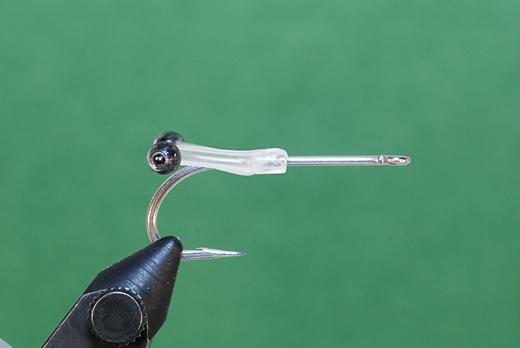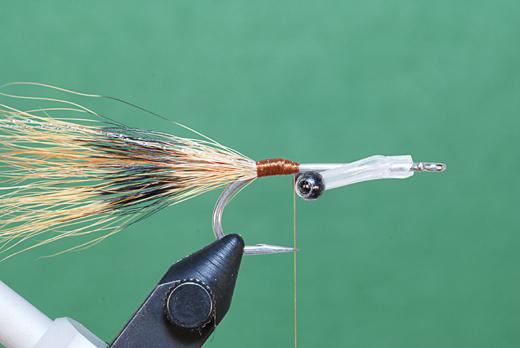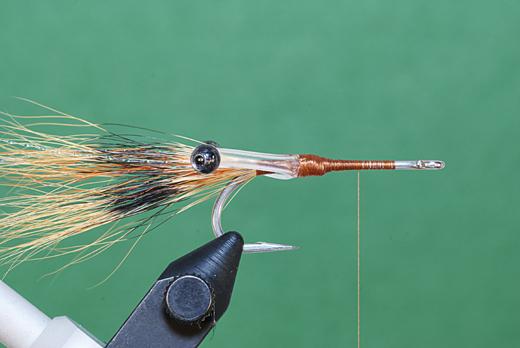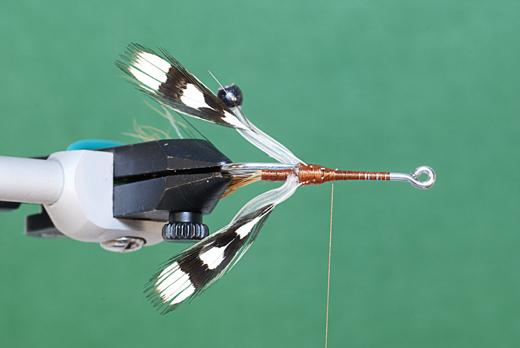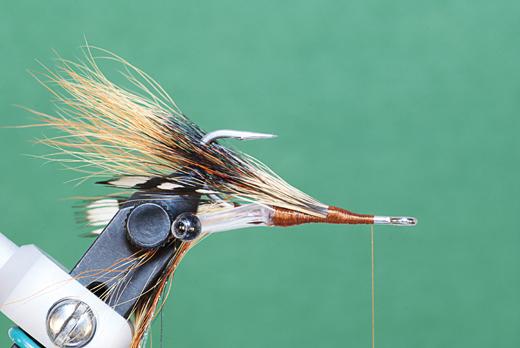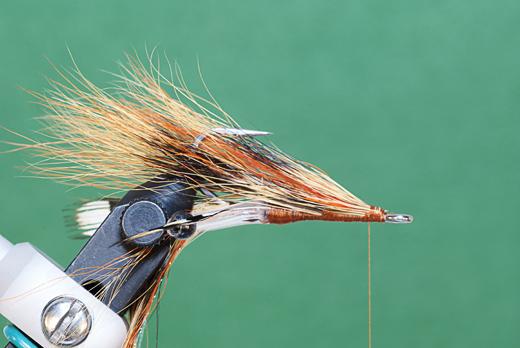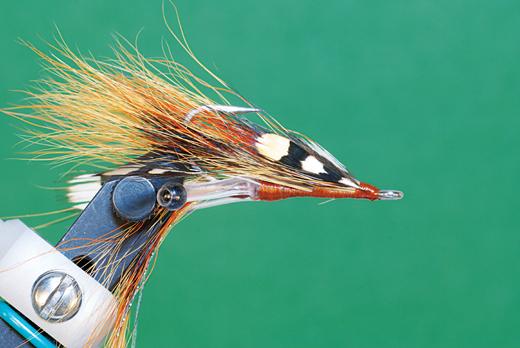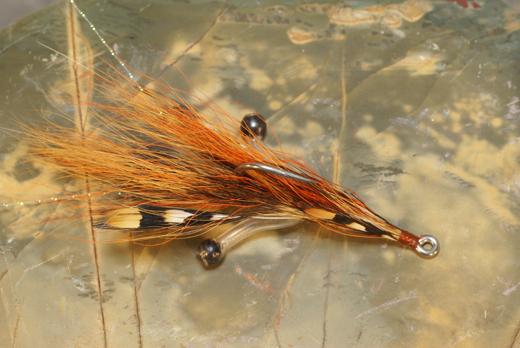
Without doubt, scuds or freshwater shrimp are the premier crustaceans in British Columbia. This celebrity status is not necessarily one of popularity with many, but it is certainly one of recognition by most. But creeping and scurrying around a number of BC waters exists a larger crustacean—the crayfish. Rich in dietary protein, we often forget about imitating crayfish in waters they inhabit, but the predators who they share their watery homes with seldom ignore them. Trout and bass, brown trout and smallmouth bass in particular, consume large numbers of crayfish. Smallmouth bass love them—they are arguably their favourite food source. If you plan on chasing smallmouth, or visiting a river or lake where crayfish exist, reserve space in your fly box for a crayfish imitation or two. For those chasing carp on the fly, crayfish patterns are fly
box staples.
Advertisement
Crayfish are widespread across North America, living in both moving and still waters. Over the course of their two-year life cycle crayfish reach appreciable size— about four inches depending upon the species. Four-inch crayfish patterns are challenging to tie and fish. Fortunately, trout, bass and carp favour smaller sized one to 2.5 inch crayfish. Patterns are typically tied on hook sizes from #2 to #10. Crayfish are smaller in the spring when most offspring are visible and active, especially during daylight hours. If you are working crayfish patterns during daylight hours, smaller inexperienced crayfish are more likely prey. As crayfish grow and mature they learn to avoid trouble by becoming nocturnal.
Crayfish blend into their natural surroundings. Mottled colour schemes of olive brown and tan are common. Some species have distinct orange claw tips. A dash of orange is common to many patterns. As with most aquatic invertebrates dark backs and lighter-colored bellies are typical. Shellbacks of raffia, Swiss Straw, Furry Foam, Midge Flex and Scud Back tied over lighter coloured bodies imitate this colour contrast. During the first year of their lives crayfish shed their exoskeleton anywhere from six to ten times. After each molt crayfish become shy and reclusive as they wait for their new exoskeleton to darken and harden. Trout and bass show a marked preference for these soft ‘shredder’ crayfish. Having a few lighter crayfish patterns on hand allows you to take advantage of this preference.
Advertisement
The primary challenge in tying crayfish patterns surrounds their profile. Many tyers lean towards a static look with the distinct claws standing proud as though the crayfish was frozen in time. Most predators avoid tackling a crayfish in a claws raised defensive posture. They often prod and poke the crayfish so it flees. Spooked crayfish use their paddle-like telsun to propel themselves backwards, with claws legs and antenna trailing. This is a profile predatory trout and bass easily handle. It is this panicked profile we should mimic at the vise. Suggestive flies, such as a brown or olive Woolly Bugger, make excellent crayfish patterns.
Mobile materials are the best option for crayfish patterns, particularly for suggesting the claws, legs and antenna. Marabou or grizzly marabou works well along with fur tufts or strips of rabbit, muskrat or squirrel. When using fur strip claws I tend to use rabbit on larger crayfish and squirrel for smaller versions. Hair, including bucktail, calftail, squirrel tail and moose, also works well, providing movement and a sense of form. Pheasant tail, small saddle feathers and, as Keith’s JC Crayfish demonstrates, jungle cock all suggest crayfish claws. Palmered hackle is also suggests movement and a crayfish’s legs. Sili Legs, Crystal Flash or stretch floss make excellent antenna choices.
Advertisement
Crayfish prefer to inhabit rocks and woody debris. Patterns tied to work and swim hook point down are a liability. Crayfish patterns designed to ride hook point up allow you to skip crawl and drift the pattern along the bottom with minimal risk of hanging ups. There are a number of techniques to get your flies to ride hook point up. The common denominator with each technique involves using the ‘keel effect’ of a weighted hook to your advantage.
Hooks ride point down in part due to the weight of the hook point, barb and bend. Strategic addition of weight overpowers this natural point down posture causing the fly to ride point up. The most popular method involves the use of dumbbell eyes secured to the top of the shank just back from the hook eye. Dumbbell eyes don’t represent the natural eyes of the crayfish as they are at the other end so tyers often use sombre, non-painted eyes. Both short and long shank curved hooks weighted with lead wire or a lead wire substitute also ride point up, a subtle approach that doesn’t sink as fast and is an ideal option for slow or stillwater applications. Small up-eye jig hooks are also excellent choices for crayfish patterns. Slide a metal cone or bead onto the shank up to the 90 degree bend to get them down. Jig hooks can also be balanced using a household pin and tungsten bead.
Fly-tyers love to imitate eyes. In many instances this is a wise approach, as profile integrity remains intact. In many instances, eyes are both a trigger and target point for the attacking predator. Crayfish are no different. Many patterns make a point of suggesting the eyes, which are located in the head or rostrum region at the base of the claws.
Mono eyes or glass beads secured to mono stalks are two popular methods. Another more durable, eco-friendly alternative is Eyes-N-Tubes, designed by Cowichan River guide Kenzie Cuthbert. Eyes-N-Tubes are a unique merger of tungsten beads and plastic tubes. They come in two styles—barbell and Y-tube— three bead colours—black, gunmetal grey and fire red—and three weights. Within each style there are three different widths of barbell eyes and two different lengths of Y-Tubes. They are perfect for suggesting crayfish eyes.
The barbell eyes are secured in place in the same manner as traditional mono or metal dumbbell eyes after they are stabbed onto the point and slid into position. Use figure eight wraps to secure. A dab of head cement or super glue provides additional security.
The Y-Tube eyes slide over the hook point and onto the shank. In most instances the eyes are initially positioned at the hook eye while the tail, and in the case of crayfish patterns, the head area, is constructed. Y-Tube eyes have a slight angle to them when viewed from the side. To ensure the hook flips, position them so the point is down below the hook axis. Move the eyes into position and cover the tube portion that was slid onto the shank with tying thread. Winding back onto Y portion of the eyes, tuck them down the shank as desired. Y-Tube eyes can also be manipulated through careful use of heat once they are tied into position. Avoid using open flame. Secure the eyes onto a thread base to ensure a firm hold. Kenzie strongly recommends coating the thread wraps with head cement or super glue prior to sliding Y-Tube eyes into position.
Although not often considered or seen by most, crayfish form a critical element in the diets of many fish. Keep this in mind. Make a point of stashing a few imposters in your fly box for future use. I bet one day they salvage a trip!
JC Crayfish Designed by Kenzie Cuthbert
Hook: Mustad S71SZ-34007 #2-#8
Thread: 6/0, Brown, Olive, Tan, Rust or Pink
Tail: Mixture of Bucktail, Red Squirrel Tail and Two Strands of Pearlescent Crystal Flash
Eyes: Eyes-N-Tubes, Y-Tubes (colour and size to suit)
Pinchers/Claws: Jungle Cock
Mid-Wing: Mixture of Bucktail and Red Squirrel Tail
Wing: Mixture of Bucktail and Red Squirrel Tail
Cheeks: Jungle Cock
Tying Note: Vary the thread, tail, and wing colours to match your local crayfish. Narrow brown (furnace) saddle hackles can be substituted for the jungle cock claws and cheeks.
Tying Instructions:
-
Via Phil Rowley De-barb the hook and slide on the Y-Tube Eyes-N-Tube onto the hook shank so the tungsten eyes point backwards. Place the hook into the vise.
-
Via Phil Rowley Temporarily slide the Eyes-N-Tube forward. Tie in the tail materials in a layered fashion so the orange bucktail is sandwiched between the squirrel tail. Tie in two strands of pearlescent Crystal Flash on top of the shank. The finished tail should be sparse and about 1.5 times the length of the shank. Build up a neat tapered thread ball from the base of the tail to a point on the shank even with the hook point.
-
Via Phil Rowley Build up an even layer of tying thread just in front of the tapered thread ball. Apply a thin coat of head cement or superglue onto the thread wraps. Roll the Y-Tube Eyes-N-Tube so they angle above the shank. Slide the Y-Tube Eyes-N-Tube tight against the tapered thread ball. Cover the plastic tube of the Y-Tube Eyes-N-Tube with tying thread locking the eyes into position. Cover the balance of the hook with tying thread and build up a neat tapered thread ramp to the Y-Tube Eyes-N-Tube.
-
Via Phil Rowley Invert the hook in the jaws or by rotating the vise. Select two reasonably narrow jungle cock feathers. Strip away the flue from the base of the feather. Tie in the prepared jungle cock eyes by the stripped stems along the sides of the shank so the feathers face shiny side up. Squashing the stems flat eases the tie in process. The bottom of the prepared feather should be approximately even with the base of the tail materials.
-
Via Phil Rowley Tie in a sparse layered clump of red squirrel tail and bucktail fibres at the mid-point so the tips extend roughly halfway up the tail. Cover the butts of the mid-wing material and build up a neat thread taper to the hook eye. Distribute the midpoint wing equally around the hook point.
-
Via Phil Rowley Tie in a sparse layered clump of red squirrel tail and bucktail fibres to form the wing. The tips of the wing should reach back to the bend of the hook. As with the mid-wing distribute the hair around the hook point.
-
Via Phil Rowley Tie in the jungle cock cheeks so the tips of the feather reach the point of the hook. Build a neat tapered head, whip finish and apply head cement.
